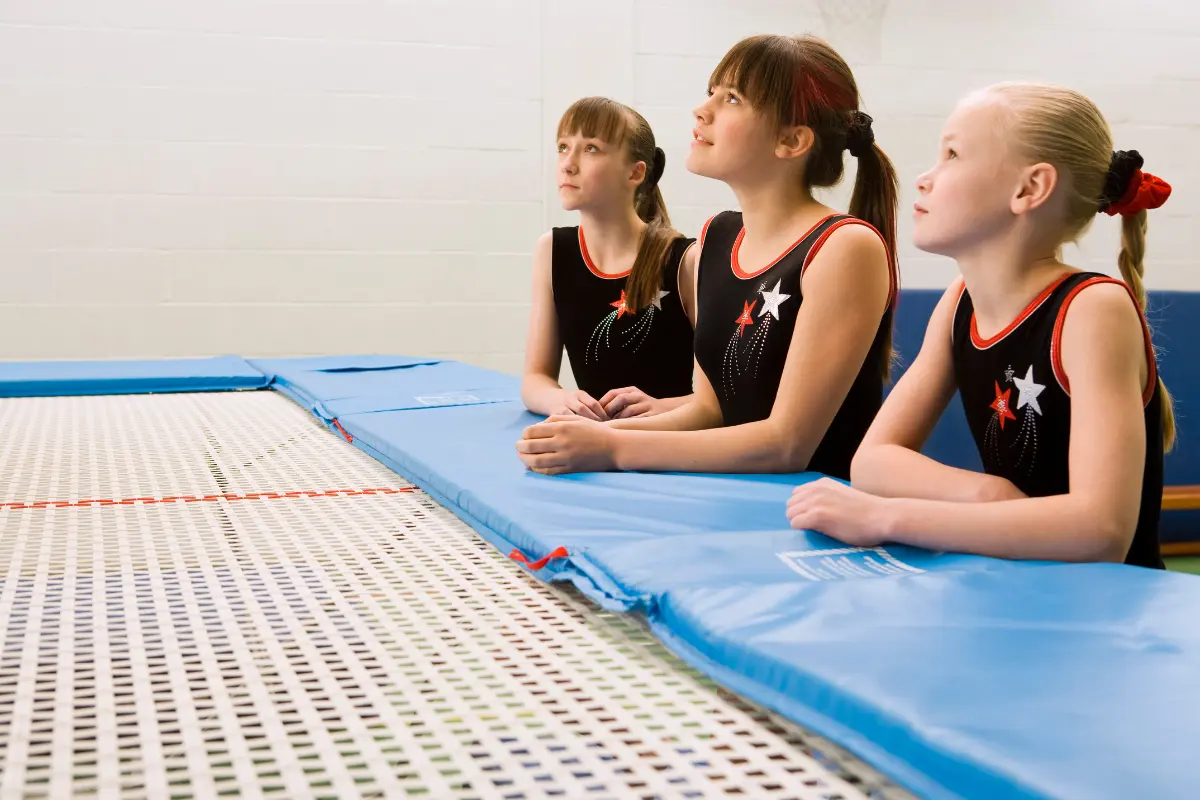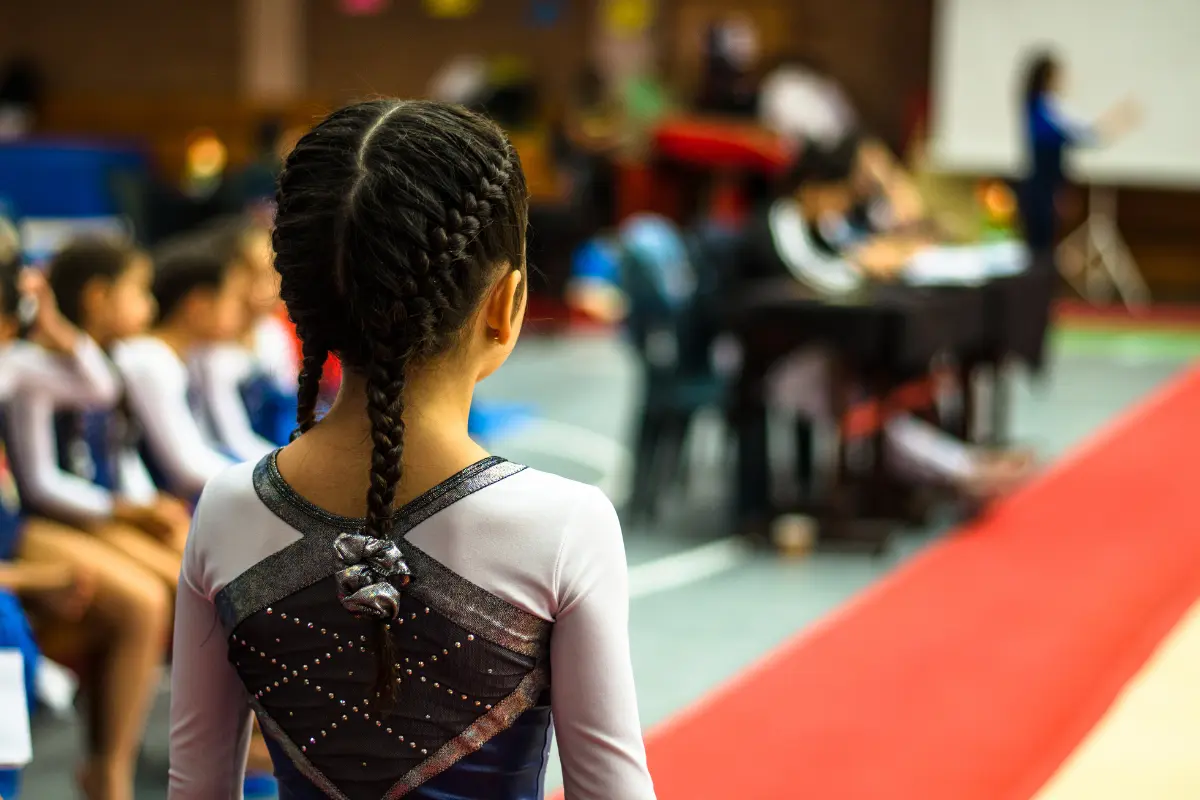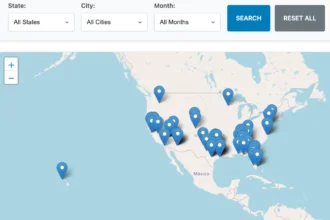Trampoline gymnastics, often referred to simply as “trampoline,” is a competitive gymnastics discipline governed by the International Gymnastics Federation (FIG). Unlike recreational bouncing, this sport involves executing a series of aerial skills on a regulation competition trampoline. Athletes perform routines that include flips, twists, and somersaults with a high degree of precision and control.
Trampoline gymnastics is one of the four competitive gymnastics disciplines recognized in the Olympics, alongside artistic, rhythmic, and acrobatic gymnastics. It became an official Olympic sport in the 2000 Sydney Games.
How High Do Trampoline Gymnasts Jump?
One of the most thrilling aspects of trampoline gymnastics is how incredibly high gymnasts can jump. At the elite level, athletes can soar up to 10 meters in the air—that’s over 30 feet, or roughly the height of a three-story building! This extraordinary airtime allows gymnasts to pack in multiple somersaults and twists before landing with precision.
This height isn’t just for show—it’s essential for high-difficulty routines. The longer a gymnast is airborne, the more time they have to execute intricate skills. That’s why judges also score for Time of Flight (ToF)—a metric that directly rewards how long a gymnast stays in the air.
For beginners, though, the journey starts much closer to the trampoline bed. Most new gymnasts begin by bouncing around 1 to 1.5 meters (3 to 5 feet) high. These early stages focus on control, timing, and body awareness. As confidence grows and technique improves, so does height.
Trampoline Gymnastics Rules and Regulations
Behind the graceful flips and soaring heights of trampoline gymnastics lies a strict set of rules that keep competitions fair, safe, and standardized. These rules are enforced by national federations and the International Gymnastics Federation (FIG), and they apply to everything from equipment specs to how routines are judged.
Equipment Standards
Let’s start with the trampoline itself. Competition trampolines are serious pieces of equipment—nothing like what you’d find in a backyard. They measure 5 meters long by 3 meters wide (about 16.4 by 9.8 feet) and have a tightly woven fabric bed that provides the lift athletes need to perform high-flying skills.
The frame is made of steel and is securely anchored, while high-tension springs ensure consistent bounce. For safety, thick padding covers the springs and frame edges, protecting gymnasts from hard landings or missed jumps.
Facility Requirements
The space around the trampoline matters just as much. Competitions are held in large indoor venues with:
- At least 2 meters of clear space around the trampoline bed
- Impact-absorbing mats on all sides
- High ceilings to accommodate jumps that can reach over 10 meters (30+ feet)
Judges, spotters, and safety personnel all operate within this cleared area to ensure a secure environment.
Competition Categories
Trampoline gymnastics includes several disciplines:
- Individual Trampoline (TRA): One gymnast performs a routine of 10 continuous skills.
- Synchronized Trampoline (SYN): Two gymnasts perform identical routines side-by-side on separate trampolines.
- Double Mini-Trampoline (DMT): Gymnasts run and perform two skills—one on the mount and one on the dismount—from a small two-level trampoline.
- Tumbling (TUM): Often grouped under trampoline disciplines, this event involves flips and twists performed on a 25-meter spring runway.
Athlete Divisions
Gymnasts are separated by age and experience level:
- Youth: Typically under 14
- Juniors: Ages 14–17
- Seniors: 18 and older
Some events also have divisions for elite and non-elite athletes, depending on national and international qualification criteria.
Judging and Scoring
Scoring in trampoline gymnastics is detailed and precise. Judges evaluate routines based on several categories:
- Difficulty (D-Score): Each skill is assigned a value. The more complex the flips, twists, and combinations, the higher the score.
- Execution (E-Score): Judges watch for clean form, pointed toes, straight legs, and controlled landings.
- Time of Flight (ToF): A timer records how long the gymnast is airborne. Higher jumps = longer flight time = more points.
- Horizontal Displacement (HD): Staying centered on the trampoline bed is key. The more an athlete drifts toward the edges, the more points they lose.
- Synchronization (S-Score): Used in synchronized trampoline, where two gymnasts are judged on how well their movements mirror each other.
Judges’ scores are averaged, and the highest and lowest scores are typically discarded to reduce bias. The final total reflects the athlete’s overall performance—both the risk and the beauty of it.e—both the risk and the beauty of it.
Skills Requirements in Trampoline Gymnastics
Athletes go through a gradual and deliberate progression of skills that begin with the basics and build toward elite-level combinations.
From your first bounce to mastering somersaults with twists, here’s how the skill journey unfolds.
The Building Blocks: Compulsory Elements
Every gymnast starts here. Compulsory skills teach control, balance, and air awareness—foundational abilities that every move builds upon.
- Straight Jump: The most basic move, but don’t be fooled—it’s key to understanding posture, balance, and staying centered on the trampoline.
- Tuck Jump: Performed by bringing the knees up to the chest in mid-air, helping gymnasts learn to rotate tightly.
- Pike Jump: Legs straight, torso folds forward at the hips. It takes flexibility and strong core control.
- Straddle Jump: A graceful move where the legs split wide in the air and the arms reach forward. It’s fun and flashy, but also great for coordination.
- Seat Drop: Land seated with legs outstretched and bounce back to your feet. It teaches control through rebound and transitions.
These may be beginner moves, but even experienced athletes return to them to fine-tune form and reset their technique.
Stepping It Up: Optional Elements
Once a gymnast has nailed the basics, they can begin to add complexity and creativity with optional elements. These skills are where routines get interesting—and where athletes start racking up Difficulty points.
- Front Somersaults: Executed in a tuck, pike, or straight (layout) position.
- Back Somersaults: Similar to the front flip but performed backward; these are fundamental to higher-level combinations.
- Barani: A forward somersault with a half twist. It’s a milestone move because it combines both rotation and twisting.
- Full Twist: A complete 360° rotation along the vertical axis. Often added to somersaults for extra difficulty.
- Double and Triple Somersaults: Only for advanced athletes. These are performed at great heights and often include multiple twists.
Each skill is given a Difficulty Value (DV) by the International Gymnastics Federation (FIG). The more complex and risky the skill, the higher its DV. The total of all DVs in a routine creates the gymnast’s Degree of Difficulty (DD)—a major component in scoring.
Technical Requirements: What Makes a Skill “Good”
It’s not just what you do in the air—it’s how you do it. Judges aren’t only looking for big tricks; they want to see clean lines, perfect posture, and confident landings. Here’s what matters most:
- Height and Amplitude: The higher a gymnast jumps, the more time they have to execute skills. It also makes routines look more dramatic and gives athletes more room to show off clean technique.
- Control and Precision: Every jump must start and finish in the center of the trampoline bed. Landing even slightly off-center leads to point deductions and can break the rhythm of a routine.
- Time of Flight (ToF): Elite routines are timed for how long the gymnast stays in the air. This metric is electronically measured and directly affects scoring.
- Form and Execution: Pointed toes, straight legs, extended arms—all the details matter. Sloppy form, bent knees, or wobbly landings will cost you.
In short, it’s not just about doing big tricks. It’s about doing them beautifully—and safely.






